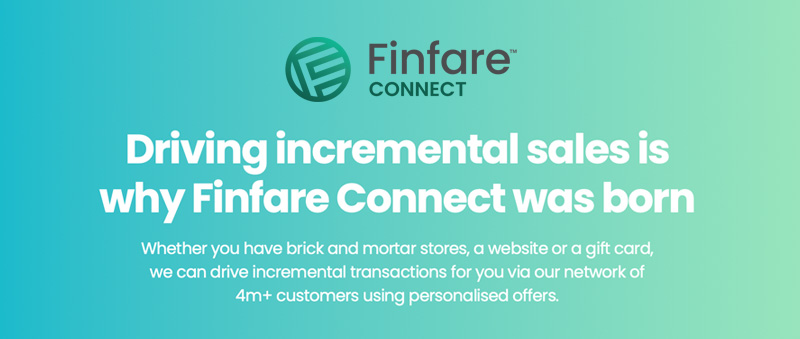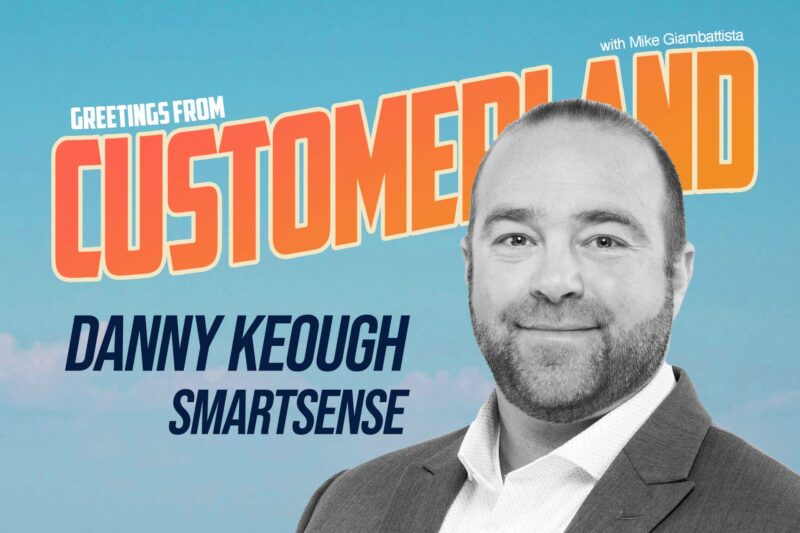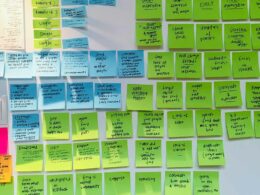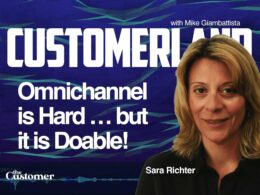Explore the advancements in IoT and the importance of customer satisfaction with Danny Keough, the global head of customer success at SmartSense. He will discuss the impact of sensing as a service and how integrated systems provide businesses with actionable insights to improve customer satisfaction. Our conversation will cover the details of implementing SmartSense solutions and their significant benefits across various industries, including healthcare and supply chain management. Danny will explain how the combination of hardware, software as a service (SaaS), and consulting enables clients to digitalize processes and make informed decisions.
This episode will highlight Smart Sense’s approach to using data not just for collection but for guiding customers towards operational efficiency, with a focus on critical areas such as neonatal intensive care units (NICUs). We will examine how Smart Sense distinguishes itself in the competitive customer experience market by consistently exceeding customer expectations. Listen to learn about SmartSense’s commitment to customer success, how it cultivates long-term business relationships, and the role of its employees in developing a customer experience model that encourages clients to become advocates.
This episode of Customerland is sponsored by

Read the full transcript below
Mike Giambattista
I’m sitting here chatting with Danny Keough, who’s head of global customer success at SmartSense and SmartSense, for those of you who don’t know, described themselves as the leading global provider of Internet of Things sensing as a service solutions that deliver dynamic and personalized asset monitoring, process digitization and digital decisioning, which is a mouthful, you pull it apart. That’s a lot of stuff, but, Danny, thanks for doing this, thanks for the time, really looking forward to your insights.
Danny Keough
Yeah, no appreciate it. You know great intro, I think. To sum it up, the big goal we try to do is just bring customer delight and value through connected IoT systems.
Mike Giambattista
Okay, so your title is head of global customer success at SmartSense. So that’s a big, big remit. It’s a big title, it’s a big remit, it implies an awful lot of stuff. But you know, within the context of what SmartSense does, can you describe what you do there and then maybe we can just kind of unpack SmartSense a little bit further.
Danny Keough
Sure, yeah, I think you know the best way to kind of describe what you know, myself and the team are doing right now is driving value. So from the delivery effort, we have project management teams, we have a field service national program that we utilize to implement our system and equipment and then that stems into customer success management. So one of the goals that we really try to drive is aligning with customers and what their desired outcomes are going to be. So assigning people to accounts to align on that, making sure you know we’re marching towards the same goals together. That’s a big, big role with what that customer success management team does. And then it kind of rounds out.
I have a tech support team. We do inbound troubleshooting calls but in the SAS, you know, model that we try to provide it’s being proactive. So a lot of what we do as well is we do outbound phone calls with that team We’ll look and find things that we can maybe prescribe some different types of actions that we want to drive changes to the customer with that group. And then, finally, is the analytics program. We call them customer success analytics. I’m sure we’ll touch on it in a minute but you know we try to go beyond the basics of what SmartSense does, which you know, maybe alerting, drawing awareness to an action. But this team tries to find trends in the data. You know it could be. You know refrigerator doors left open could be the second chicken temp cook on Tuesdays. And region two is, you know, the coaching opportunity. So they kind of get down with the data.
Mike Giambattista
Wow, that’s a lot of stuff. Can you so, just from the earlier description, have a sense that there’s hardware involved, it’s IoT signaling, it’s a lot of analysis and insights? Can you describe just in a practical sense somebody’s deploying SmartSense? Is it mostly a hardware consideration? Is it mostly a SaaS consideration, where it’s insights analysis, or is it more of a consulting application? How does it all work there? What does it look like?
Danny Keough
Yeah, no great question. The way we like to position this is that we’re a SaaS business. We utilize all kinds of different sensors, but the main goal is to provide you with data insights but, more importantly, awareness into the data. I think that’s one of the coolest parts about the job is customers. A lot of time they may have an idea that they may have some challenges, but when we get the data and we start collecting all the different data points, you start realizing oh, maybe my problem is a little bit more than I realized. But more importantly, what SmartSense tries to do is prescribe those actions on where you can make it better. Coaching opportunities is what we like to call it. It’s really connecting that platform, trying to give a single-paying view and really empowering the customer to be successful.
Mike Giambattista
Interesting. I’m already thinking of about 30 use cases right now. That may or may not be real ones, but there’s a lot of utility for what you guys do. What are some of the primary verticals that you’re operating in?
Danny Keough
Yeah, so generally we cover. I would look at three core verticals, which would be healthcare, food service, warehouse, supply chain. But then within them, food service can entail grocery, convenience stores, hospitality, catering we have a big presence in K-12, colleges and universities and then healthcare is similar. That bucket kind of stems into retail pharma, pharmaceutical manufacturing, blood banks, general hospital cares, ors, ers, kind of that cascaded net. So it kind of has deep roots.
Mike Giambattista
Okay, so you’re operating as a SaaS model. I’m skating around what’s probably really obvious to you and everybody else listening, but I haven’t quite found it yet. The SaaS solution that you’re providing is a function of plugging into existing IoT inputs and then providing analysis and insight to that correct? Do I have that close to right?
Danny Keough
Yeah, so through a combination of deploying our hardware and our software solutions and analytics, there’s also opportunities where we’ll tell customers hey, connect us with some of the other vendors you’re utilizing and let’s find ways to put you at the center of all this. And that’s where you start to provide a wider net of solutions which drives value. Okay, All right.
Mike Giambattista
Starting to come into focus. It took a few minutes, but I’m starting to get it. As I suspected, because of the nature of what SmartSense does and what you do within SmartSense, you probably have insights globally that a lot of people don’t have. So that’s why, when Nikki and her team reached out with your 2024 predictions, I mean, let’s face it, everybody has 2024 predictions at the end of 2023 and you have to pick and choose who you really want to listen to. But based on the sheer quantity of data that you guys have going through your hands, it seems like you’re going to possess some insights that probably not many people do.
So, without giving away anything we shouldn’t proprietary or otherwise, I’m dying to hear you look into and operate within the CX space pretty deeply clearly. What do you see? What are some of the biggest? If I say trends, it’s just too easy because you know let me phrase it this way If you’re a CX provider, if you’re a CX professional, what are some of the things that you see that you would like to advise these people that need to be aware of?
Danny Keough
So maybe the best way to answer that is I’ll share a story. So this kind of came from one of our customers where we implement our solution and system and it’s a NICU environment and you know I’ll never forget. You know, before we deployed the system, you know, he kind of said right out of the gate you know, Danny, a lot of these kids come into the world with strike one and my job is to make sure they never hit strike two. Your job is to give me the data and information to make sure you know the medications and stuff we’re giving these kids are where they need to be. So, having said that and kind of to your question, you know what we do with our data is we start to identify you know again hate to say the word trends, but we identify areas where maybe gaskets on refrigerators will prescribe actions that those need to replace. It could be adjusting set points, it could be the doors are being left open. It could be placement, Maybe there’s ice buildup in certain areas.
So we try to give them that insight and analysis, because gone are the days of set it and forget it. Customers, they want to be proactive and in this situation, you know it’s for a very, you know, huge cause and being proactive to protect lives. So they’re leveraging that kind of data to really drive efficiencies which, and then you know, in turn protects their patients. So I think it’s just a great way to kind of to synergize when you look ahead with customer success. You know, taking analytics and the data and the different types of modeling points that you put together where you can drive more value, more targeted actions to making those improvements. You know that’s what’s really going to pull people through.

Mike Giambattista
How would you hope this isn’t? I’m trying to formulate something that actually sounds like a question and it’s not quite there yet. So I get the utility. I completely get it. How would you map that out into the worlds of people who need to be concerned with customer success and customer experience to show them that they need to be more proactive in this way, is it? I’ll let you try and answer that question. That’s not even really a question.
Danny Keough
Yeah, I know, I think it’s, you know, all solutions. We want them to kind of operate around themselves and I think there’s uncertainty with technology, there’s fear of failing and the companies I think do it well is one of the larger pieces of the organization is that customer success model, and that’s something we brought with SmartSense, with our president guy and our team, is we really wanted to ensure that our customer felt the value of the services we offer from the start, from the sales side, from pre-sales to the delivery, and then the success side. So kind of uncovering some of those uncertainties really allowed us to drive that. And then ultimately I don’t know if you’re familiar with the book Raving Fans, but that’s something we all read as a customer success team and it boiled down to deciding what we wanted to do with our customers and then discovering what our customers were on it from us and then execute on those visions.
Mike Giambattista
So when you’re identifying new client opportunities, you know you can go about this the way I’m sure you do partially. You know you’re going to respond to RFPs, but if you’re out there scouring the world for the ideal client to take advantage of your offerings, what does that client look like? Are there any kind of you know? Here’s some key factors we look for in great people to work with.
Danny Keough
I think you know it’s really looking for customers that have identified problems they want to solve. You know that may be around energy consumption, maybe around waste, but usually it’s. You know we try to do that discovery of. You know there’s a lot of solutions out there. So tell us what you’re trying to solve and then we’ll work towards that solution and then that’s where the team kind of drives. You know, once the solution is implemented, how do we scale it, how do you have success with it? And that’s where we position the customer success program as a differentiator, because SmartSense has invested a lot in that to making sure customers are successful. Hope that answered your question.
Mike Giambattista
Yeah, it wasn’t much of a question. Sorry, this maybe hopefully will improve as we go on. Here Are there. Forgive me, this is way too deep into weeds, but are there stack dependencies? Are there any technological dependencies? That SmartSense? You know you need to work with making this totally up, but you know you can only work with the SAP ecosystem to make the most sense out of your operation. Or is it? You know you need XYZ components in the stack to make it work, or are you? Is SmartSense kind of agnostic to the hardware and then you know whatever internal CDPs or BI tools companies may have.
Danny Keough
Yeah, I think the way we like to position it is flexibility with our configuration. So what that means is we leverage APIs where needed. Customers can tie them into BI systems and tools, the end users. We try to keep it as simple as possible, meaning that there doesn’t need to be a high technical proficiency behind it, and that’s again the value of what we partner with. The customer will apply resources and will guide them. Here’s what we seek successful from an alerting standpoint. We’ll cascade a hierarchy and a lot of it is just identifying. You know, hey, we like this. We want text messages, we want alerting to these groups of individuals, or when you have analytics, we want them to go to this group of individual and we just kind of configure that system to where it’s optimal for them to arrive at.
Mike Giambattista
Cool I’m thinking of. We interact with a fair amount of CX technology providers because of what we do and some of it’s pretty sophisticated technology and I’m just running through, I don’t think, I don’t think I’m aware of anybody out there who’s got kind of an integrated functionality with IoT. It seems to me. You know, there’s all kinds of telephony crazy stuff there and there’s all kinds of voice and sentiment analysis and you know what you can do with AI there, but I can’t think of anybody who’s actually selling a feature set based on IoT in the CX space, which, if I’m right I may not be right it’s a pretty big opportunity.
Danny Keough
Yeah, I think it is and I think it’s. You know, where most customers kind of like I mentioned before, it’s the little, the fear of the uncertainty. They want to be successful with a project like this. You know their name is stamped and tied to the project. So where you can bring that value, show them the value of that insights, whether it is through features and functionality. We like to just kind of roll it on the value of the demand, right, so we’ll point out these are certain areas where maybe your alarms were lasting four hours, five hours at a time. Here’s the coaching we drove with the end users in the regions and now you’ve got it down to an hour. Let’s celebrate that, let’s talk internally with your leadership about that and it becomes more of a partnership. And that’s to me that’s the fun value, when customers view you as a partner, not just a vendor.
Mike Giambattista
Yeah, I mean, what you’re describing goes well beyond just analysis and insights. You’re, you know, helping them navigate cultural change, even sometimes.
Danny Keough
Absolutely, and then that leads to other opportunities, right? Hey, you helped me with this. I’m also having a challenge with this and it’s like all right, well, let’s connect us where we need to be connected to and let’s help make it better for you.
Mike Giambattista
Super interesting. So I’m looking at the one of the items that your team had sent over in advance of this call and I’m really intrigued to see where this goes. But the headline of this particular section is why fit in when your CX models can stand out? So to me I mean, of course, yes, yes, yes. What can a CX team do to make their models stand out?
Danny Keough
I think it boils down to being proactive. I think you know customers want that offense approach and I think, especially with the scale that we build and we operate on, some of our customers have thousands and thousands and thousands of locations and being able to separate ourselves from one company to another. It’s being proactive with our analytics, being proactive with our actions, identifying trends like weather patterns. You know, hurricanes are going through. Here’s what we recommend. And it’s like oh, I haven’t thought about that, thank you for telling us. And then the returns we get is, you know, with our CX model, customers would tell us like hey, you know so and so that they’re a part of our family or they’re a part of our operation now, and that’s a cool place to be when you’re kind of trying to separate from a market that has a lot of players in it.
Mike Giambattista
Yeah, and yeah, completely agree, I’m nodding. You can’t tell them on the podcast when I’m nodding, in agreement.
Danny Keough
It’s a fun world, fun world to be in when you’re in this, yeah it really is.
Mike Giambattista
I mean, affecting customer sentiment is, as we know, really important, but it’s also to do it well is really difficult. You know, you can create a momentary like thumbs up or even you know, some sort of moment of passion, if you will, but sustaining that in a scalable way is really, really, really difficult and it seems like what you’re saying, yeah please go ahead.
Danny Keough
Yeah, we’ve been really lucky We’ve had some just amazing employees that have really bought into what we’re trying to do from a CS program and company and then it becomes more second nature. So it’s a little easier because when you wake up in the day you know I’ll have some of my staff tell me like hey, I was actually thinking of calling so and so and you know their son their birthday’s next week and it’s like you got to that level of a relationship with them from the value and it just stemmed into you know that kind of relationship and it becomes easy to people to talk business and then personal when you build that completely, completely agree.
Mike Giambattista
Yeah, it’s refreshing to talk to a company that has a big client list that still views these things on an individual relationship basis. Yeah, I love hearing that, love hearing that, Love hearing that.














